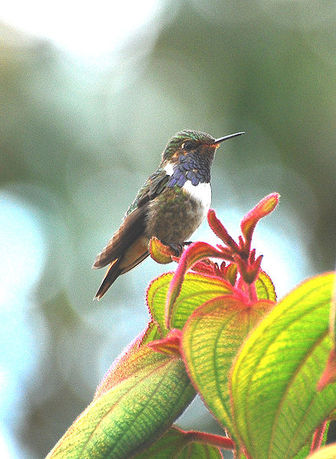Volcano Hummingbird
This tiny endemic bird inhabits open brushy areas, paramo, and edges of elfin forest at altitudes from 1850 m to the highest peaks. It is only 7.5 cm long. The male weighs 2.5 g and the female 2.8 g. The black bill is short and straight.

Original source: DSC_5007a.jpg
Author: Jerry Oldenettel from Socorro, NM, USA
The Volcano Hummingbird is classified as Least Concern. Does not qualify for a more at risk category. Widespread and abundant taxa are included in this category.
The Volcano Hummingbird (Selasphorus flammula) is a very small hummingbird which breeds only in the mountains of Costa Rica and Chiriqui, Panama. This tiny endemic bird inhabits open brushy areas, paramo, and edges of elfin forest at altitudes from 1850 m to the highest peaks. It is only 7.5 cm long. The male weighs 2.5 g and the female 2.8 g. The black bill is short and straight. More
The female Volcano Hummingbird is entirely responsible for nest building and incubation. She lays two white eggs in her tiny plant-down cup nest 1-5 m high in a scrub or on a root below a south or east facing bank. Incubation takes 15-19 days, and fledging another 20-26. The food of this species is nectar, taken from a variety of small flowers, including Salvia and Fuchsia, and species normally pollinated by insects. More
Volcano Hummingbird is the actual name of this tiny hummmer which is found specially in the cold mountain area near the volcanoes in Costa Rica. Canon EOS 350D with Sigma 70-300 @ f/5.6, 1/500, ISO-200, focal length 300mm. More
Volcano Hummingbird at the Mirador de Quetzals, Costa Rica Photograph by Jerry Oldenettel from Socorro, NM, USA. Some rights reserved. Volcano Hummingbird | Selasphorus flammula photo Volcano Hummingbird at the Mirador de Quetzals, Costa Rica Photograph by Jerry Oldenettel from Socorro, NM, USA. Some rights reserved. More
jpgClose-up view of a volcano hummingbird (Selasphorus flammula) feeding from the nectar of a fuchsia flower, Costa Rica. Close-up view of a volcano hummingbird (Selasphorus flammula) feeding from the nectar of a fuchsia flower, Costa Rica. More
The tiny Volcano Hummingbird is one of Costa Rica's smallest, lives on the highland slopes of volcanoes. Three populations have become geographically separated by intervening valleys, and have evolved different iridescent gorget (throat) colors: red, violet, and metallic gray. In the future they may be considered three different species. More

Original source: Hans Zwitzer
Author: Hans Zwitzer
Permission: Some rights reserved
Family : Trochilidae
Genus : Selasphorus
Species : flammula
Authority : Salvin, 1864
